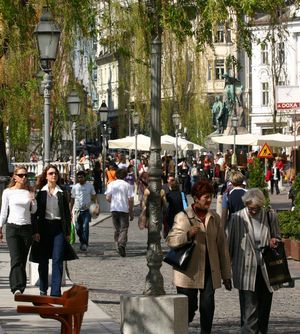
 Number of inhabitants: There are 2,010,377 (2006) inhabitants in Slovenia. 1,023,395 of these are women. In 2006, over 53 thousand foreign nationals were living in Slovenia.
Number of inhabitants: There are 2,010,377 (2006) inhabitants in Slovenia. 1,023,395 of these are women. In 2006, over 53 thousand foreign nationals were living in Slovenia.
Biggest towns: Ljubljana (258,873), Maribor (93,847), Celje (37,834), Kranj (35,587), Velenje (26,742), Koper (23,726), Novo mesto (22,415), Ptuj (18,339), Trbovlje (16,290), Nova Gorica (13,491), Jesenice (13,429), Murska Sobota (12,437)
Age structure of the population: The average age is 40.4 years: 14% under 15 years old; 70.2% between 15 and 64; 5.7% 65
Birth rate: -0.3 (9.1 births, 9.3 deaths) per thousand inhabitants (2005)
Net migration increase: 3.2 per 1000 inhabitants
Life expectancy: average life expectancy for males: 74.08 years; for women: 81.3 (2005)
Population density: 98.8 inhabitants per km2
Population by nationality: Slovenes: 83.06%; Serbs: 1.98%; Croatians: 1.81%; Bosniaks: 1.1%; other: 6.43% (2002 Census)
Population by religion: There are 43 religious denominations currently registered in Slovenia. The majority of the population (57.8%) declared themselves Roman-Catholic in the census of 2002. 2.4% of the population are Muslims, 2.3% are Serbian Orthodox, and 0.8% are Protestants. 10.1% of the population are atheists.